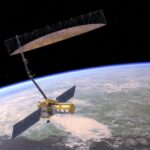The asteroid, roughly the size of an airplane and known as 2024 NS1, is set to make a close approach to Earth on August 2.
NASA has issued a warning after detecting a 150-foot (46-meter) asteroid, designated 2024 NS1, traveling towards Earth at a high velocity of 27,274 km/h. The asteroid, comparable in size to a small airplane, is expected to make its closest approach on August 2 at 00:05 UTC (5:35 IST).
Classified as an Apollo asteroid, 2024 NS1 is part of a group of near-Earth objects (NEOs) whose orbits intersect Earth’s path. While many of these objects remain far from Earth, some come closer and are categorized as potentially hazardous due to their proximity and size.
Although 2024 NS1 does not fall into the potentially hazardous category—defined as objects larger than 460 feet (140 meters) that come within 7.5 million kilometers of Earth—it will pass safely at a distance of nearly 2 million kilometers.
Despite its non-threatening status, NASA is closely monitoring the asteroid to ensure its trajectory remains stable.
If a similar-sized asteroid were to impact Earth, the consequences would depend on various factors including size, speed, and impact location. A 150-foot asteroid could cause localized damage and injuries, whereas larger asteroids could lead to severe climate changes and tsunamis.
NASA’s Center for Near-Earth Object Studies (CNEOS) oversees the monitoring of NEOs to assess potential risks. Data from the Minor Planet Center and NASA-funded observatories like Pan-STARRS, the Catalina Sky Survey, and NEOWISE provide critical information on asteroid trajectories. Future observations will be enhanced by the NEO Surveyor mission, and planetary radar projects such as JPL’s Goldstone Solar System Radar Group contribute to ongoing tracking efforts.
Currently, all data indicate that asteroid 2024 NS1 will pass by Earth without posing any threat.












